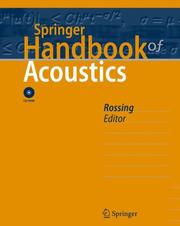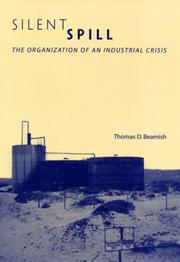| Listing 1 - 10 of 98 | << page >> |
Sort by
|

ISBN: 0387304258 0387304460 0387336338 Year: 2007 Publisher: New York, N.Y. : Springer,
Abstract | Keywords | Export | Availability | Bookmark
 Loading...
Loading...Choose an application
- Reference Manager
- EndNote
- RefWorks (Direct export to RefWorks)
Acoustics, the science of sound, has developed into a broad interdisciplinary field encompassing the academic disciplines of physics, engineering, psychology, speech, audiology, music, architecture, physiology, neuroscience, and others. The Springer Handbook of Acoustics is an unparalleled modern handbook reflecting this richly interdisciplinary nature edited by one of the acknowledged masters in the field, Thomas Rossing. Researchers and students benefit from the comprehensive contents spanning: animal acoustics including infrasound and ultrasound, environmental noise control, music and human speech and singing, physiological and psychological acoustics, architectural acoustics, physical and engineering acoustics, signal processing, medical acoustics, and ocean acoustics. This handbook reviews the most important areas of acoustics, with emphasis on current research. The authors of the various chapters are all experts in their fields. Each chapter is richly illustrated with figures and tables. The latest research and applications are incorporated throughout, e.g. computer recognition and synthesis of speech, physiological acoustics, psychological acoustics, thermoacoustics, diagnostic imaging and therapeutic applications and acoustical oceanography. With a Foreword by Manfred R. Schroeder Key Topics Physical and Engineering Acoustics Signal Processing in Acoustics Physiological and Psychological Acoustics Architectural Acoustics Medical Acoustics Ocean Acoustics Environmental Noise Control Musical Acoustics, Human Speech and Singing Animal Acoustics (Infrasound and Ultrasound) Features Contains over 960 two-color illustrations. Includes over 80 comprehensive tables. Emphasizes physical concepts over extensive mathematical derivations. Delivers a wealth of up-to-date references. Parts and chapters with summaries, detailed index and fully searchable CD-ROM guarantee quick access to data and links to other sources. Audio and video files on CD-ROM.
Sound. --- Acoustical engineering. --- Acoustic engineering --- Sonic engineering --- Sonics --- Sound engineering --- Sound-waves --- Engineering --- Acoustics --- Continuum mechanics --- Mathematical physics --- Physics --- Pneumatics --- Radiation --- Wave-motion, Theory of --- Industrial applications --- Acoustics. --- Animal physiology. --- Engineering. --- Animal Physiology. --- Classical Electrodynamics. --- Engineering, general. --- Signal, Image and Speech Processing. --- Construction --- Industrial arts --- Technology --- Animal physiology --- Animals --- Biology --- Anatomy --- Physiology --- Optics. --- Electrodynamics. --- Signal processing. --- Image processing. --- Speech processing systems. --- Dynamics --- Light --- Computational linguistics --- Electronic systems --- Information theory --- Modulation theory --- Oral communication --- Speech --- Telecommunication --- Singing voice synthesizers --- Pictorial data processing --- Picture processing --- Processing, Image --- Imaging systems --- Optical data processing --- Processing, Signal --- Information measurement --- Signal theory (Telecommunication) --- Physiology. --- Technology and Engineering. --- Signal, Speech and Image Processing . --- Sound --- Acoustical engineering --- Research. --- History.
Book
ISBN: 9783319200194 3319200186 9783319200187 3319200194 Year: 2015 Publisher: Cham : Springer International Publishing : Imprint: Springer,
Abstract | Keywords | Export | Availability | Bookmark
 Loading...
Loading...Choose an application
- Reference Manager
- EndNote
- RefWorks (Direct export to RefWorks)
This thesis is concerned with establishing a rigorous, modern theory of the stochastic and dissipative forces on crystal defects, which remain poorly understood despite their importance in any temperature dependent micro-structural process such as the ductile to brittle transition or irradiation damage. The author first uses novel molecular dynamics simulations to parameterise an efficient, stochastic and discrete dislocation model that allows access to experimental time and length scales. Simulated trajectories are in excellent agreement with experiment. The author also applies modern methods of multiscale analysis to extract novel bounds on the transport properties of these many body systems. Despite their successes in coarse graining, existing theories are found unable to explain stochastic defect dynamics. To resolve this, the author defines crystal defects through projection operators, without any recourse to elasticity. By rigorous dimensional reduction, explicit analytical forms are derived for the stochastic forces acting on crystal defects, allowing new quantitative insight into the role of thermal fluctuations in crystal plasticity.
Physics. --- Solid State Physics. --- Statistical Physics, Dynamical Systems and Complexity. --- Numerical and Computational Physics. --- Physique --- Crystals -- Defects -- Mathematical models. --- Dislocations in crystals -- Mathematical models. --- Physics --- Physical Sciences & Mathematics --- Atomic Physics --- Dislocations in crystals --- Crystals --- Mathematical models. --- Defects --- Crystals, Dislocations in --- Dislocation theory --- Dislocations (Crystals) --- Solid state physics. --- Statistical physics. --- Dynamical systems. --- Crystallography --- Powders --- Solids --- Deformations (Mechanics) --- Grain boundaries --- Plasticity --- Twinning (Crystallography) --- Complex Systems. --- Numerical and Computational Physics, Simulation. --- Statistical Physics and Dynamical Systems. --- Mathematical statistics --- Statistical methods --- Dynamical systems --- Kinetics --- Mathematics --- Mechanics, Analytic --- Force and energy --- Mechanics --- Statics --- Natural philosophy --- Philosophy, Natural --- Physical sciences --- Dynamics
Book
ISBN: 1489982140 1441971092 9786613077431 1441971106 1283077434 Year: 2010 Publisher: New York : Springer Science,
Abstract | Keywords | Export | Availability | Bookmark
 Loading...
Loading...Choose an application
- Reference Manager
- EndNote
- RefWorks (Direct export to RefWorks)
Many performing musicians, as well as instrument builders, are coming to realize the importance of understanding the science of musical instruments. This book explains how string instruments produce sound. It presents basic ideas in simple language, and it also translates some more sophisticated ideas in non-technical language. It should be of interest to performers, researchers, and instrument makers alike.
Music -- Acoustics and physics. --- Musical instruments -- Construction. --- Musical intervals and scales. --- Stringed instruments -- Acoustics. --- Stringed instruments --- Physics --- Music --- Music, Dance, Drama & Film --- Physical Sciences & Mathematics --- Acoustics & Sound --- Music Philosophy --- Acoustics --- Acoustics. --- Acoustics and physics. --- Musical acoustics --- Instruments, Stringed --- String instruments --- Physics. --- Music. --- Vibration. --- Dynamical systems. --- Dynamics. --- Acoustical engineering. --- Engineering Acoustics. --- Vibration, Dynamical Systems, Control. --- Sound --- Monochord --- Musical instruments --- Acoustics in engineering. --- Cycles --- Mechanics --- Art music --- Art music, Western --- Classical music --- Musical compositions --- Musical works --- Serious music --- Western art music --- Western music (Western countries) --- Dynamical systems --- Kinetics --- Mathematics --- Mechanics, Analytic --- Force and energy --- Statics --- Acoustic engineering --- Sonic engineering --- Sonics --- Sound engineering --- Sound-waves --- Engineering --- Industrial applications
Book
ISBN: 3319310739 3319310755 Year: 2016 Publisher: Cham : Springer International Publishing : Imprint: Springer,
Abstract | Keywords | Export | Availability | Bookmark
 Loading...
Loading...Choose an application
- Reference Manager
- EndNote
- RefWorks (Direct export to RefWorks)
This ambitious and accessible guide reviews innovative technologies enhancing the field of neuropsychological testing. Starting with the premise that standard batteries—some nearly a century old—lag behind in our era of neuroimaging, genomic studies, psychophysiology, and informatics, it presents digital measures offering more efficient administration, more accurate data, and wider clinical applications. Ecological validity and evidence-based science are key themes in these advances, from virtual environments and assessment of social cognition to the shift toward situational reliability and away from lab-created constructs. These chapters also demonstrate how high-tech assessment tools can complement or supplement traditional pencil-and-paper measures without replacing them outright. This book covers in depth: · The evolution of neuropsychological testing over the past century. · Current applications of computer-based neuropsychological assessments. · The strengths and limitations of simulation technology. · The use of teleneuropsychology in reaching remote clients. · The potential of gaming technologies in neurocognitive rehabilitation. · How technology can transform test data into information useful across specialties. Clinical Neuropsychology and Technology brings neuropsychologists, clinical psychologists, and rehabilitation specialists into the vanguard of assessment measures and processes that will translate into more accurate testing, collaborations between disciplines, and valid and useful outcomes.
Psychology. --- Rehabilitation. --- Neuropsychology. --- Cognitive psychology. --- Cognitive Psychology. --- Neuropsychological tests. --- Cognition. --- Neuropsychological assessment --- Neuropsychological evaluation --- Tests, Neuropsychological --- Neurophysiology --- Psychophysiology --- Psychology --- Clinical neuropsychology --- Neurologic examination --- Psychological tests --- Psychology, clinical. --- Consciousness. --- Apperception --- Mind and body --- Perception --- Philosophy --- Spirit --- Self --- Psychology, Cognitive --- Cognitive science

ISBN: 9027247390 9786613312150 1283312158 9027275394 9789027275394 9781588113139 1588113132 9781283312158 9789027247391 1588113132 9789027247391 Year: 2002 Publisher: Amsterdam : Benjamins,
Abstract | Keywords | Export | Availability | Bookmark
 Loading...
Loading...Choose an application
- Reference Manager
- EndNote
- RefWorks (Direct export to RefWorks)
This brief monograph explores the historical motivations for two sets of phonological changes in some varieties of Romance: restructured voicing of intervocalic /p t k/, and palatalization of initial /l/ and /n/. These developments have been treated repeatedly over the decades, yet neither has enjoyed a satisfactory solution. This book attempts to demonstrate that both outcomes are ultimately attributable to the loss of early pan-Romance consonant gemination.This study is of interest not only to the language-specific field of historical Romance linguistics, but also to general historical
Romance languages --- Neo-Latin languages --- Italic languages and dialects --- Phonology, Historical. --- Phonology, Comparative. --- Voice.

ISBN: 0807864307 0807848174 0807822388 9780807864302 9780807822388 9780807848173 9798890882936 Year: 1996 Publisher: Chapel Hill : University of North Carolina Press,
Abstract | Keywords | Export | Availability | Bookmark
 Loading...
Loading...Choose an application
- Reference Manager
- EndNote
- RefWorks (Direct export to RefWorks)
Slavery --- Law and legislation --- History. --- Abolition of slavery --- Antislavery --- Enslavement --- Mui tsai --- Ownership of slaves --- Servitude --- Slave keeping --- Slave system --- Slaveholding --- Thralldom --- Crimes against humanity --- Serfdom --- Slaveholders --- Slaves --- Enslaved persons

ISBN: 0262267977 0585442568 0262261707 9780585442563 9780262267977 9780262025126 9780262261708 Year: 2002 Publisher: Cambridge, Mass. MIT Press
Abstract | Keywords | Export | Availability | Bookmark
 Loading...
Loading...Choose an application
- Reference Manager
- EndNote
- RefWorks (Direct export to RefWorks)
In the Guadalupe Dunes, 170 miles north of Los Angeles and 250 miles south of San Francisco, an oil spill persisted unattended for 38 years. Over the period 1990-1996, the national press devoted 504 stories to the Exxon Valdez accident and a mere nine to the Guadalupe spill -- even though the latter is most likely the nation's largest recorded oil spill. Although it was known to oil workers in the field where it originated, to visiting regulators, and to locals who frequented the beach, the Guadalupe spill became troubling only when those involved could no longer view the sight and smell of petroleum as normal. This book recounts how this change in perception finally took place after nearly four decades and what form the response took. Taking a sociological perspective, Thomas Beamish examines the organizational culture of the Unocal Corporation (whose oil fields produced the leakage), the interorganizational response of regulatory agencies, and local interpretations of the event. He applies notions of social organization, social stability, and social inertia to the kind of environmental degradation represented by the Guadalupe spill. More important, he uses the Guadalupe Dunes case as the basis for a broader study of environmental "blind spots." He argues that many of our most pressing pollution problems go unacknowledged because they do not cause large-scale social disruption or dramatic visible destruction of the sort that triggers responses. Finally, he develops a model of social accommodation that helps explain why human systems seem inclined to do nothing as trouble mounts.
Oil spills --- Petroleum industry and trade --- Pollution --- Public opinion --- Environmental aspects --- Public opinion. --- Guadalupe-Nipomo Dunes National Wildlife Refuge (Calif.) --- Environmental conditions --- Opinion, Public --- Perception, Public --- Popular opinion --- Public perception --- Public perceptions --- Chemical pollution --- Chemicals --- Contamination of environment --- Environmental pollution --- Oilspills --- Judgment --- Social psychology --- Attitude (Psychology) --- Focus groups --- Reputation --- Contamination (Technology) --- Asbestos abatement --- Bioremediation --- Environmental engineering --- Environmental quality --- Factory and trade waste --- Hazardous waste site remediation --- Hazardous wastes --- In situ remediation --- Lead abatement --- Pollutants --- Refuse and refuse disposal --- Energy industries --- Oil industries --- Environmental disasters --- Oil pollution of rivers, harbors, etc. --- Oil pollution of the sea --- ENVIRONMENT/General --- SOCIAL SCIENCES/Sociology
Book
ISBN: 0804794650 0804784426 9780804794657 9780804784429 Year: 2015 Publisher: Stanford, California : Stanford Business Books,
Abstract | Keywords | Export | Availability | Bookmark
 Loading...
Loading...Choose an application
- Reference Manager
- EndNote
- RefWorks (Direct export to RefWorks)
In 2001, following the events of September 11 and the Anthrax attacks, the United States government began an aggressive campaign to secure the nation against biological catastrophe. Its agenda included building National Biocontainment Laboratories (NBLs), secure facilities intended for research on biodefense applications, at participating universities around the country. In Community at Risk, Thomas D. Beamish examines the civic response to local universities' plans to develop NBLs in three communities: Roxbury, MA; Davis, CA; and Galveston, TX. At a time when the country's anxiety over its security had peaked, reactions to the biolabs ranged from vocal public opposition to acceptance and embrace. He argues that these divergent responses can be accounted for by the civic conventions, relations, and virtues specific to each locale. Together, these elements clustered, providing a foundation for public dialogue. In contrast to conventional micro- and macro-level accounts of how risk is perceived and managed, Beamish's analysis of each case reveals the pivotal role played by meso-level contexts and political dynamics. Community at Risk provides a new framework for understanding risk disputes and their prevalence in American civic life.
Risk management --- Biosecurity --- Biological laboratories --- Bioterrorism --- Public opinion --- Local government --- Political aspects --- Prevention --- Research --- Local administration --- Township government --- Opinion, Public --- Perception, Public --- Popular opinion --- Public perception --- Public perceptions --- Bio-terrorism --- Biological terrorism --- Law and legislation --- Insurance --- Management --- Subnational governments --- Administrative and political divisions --- Decentralization in government --- Public administration --- Judgment --- Social psychology --- Attitude (Psychology) --- Focus groups --- Reputation --- Terrorism --- Laboratories --- Human security --- Biological weapons --- Communicable diseases --- Public health --- Safety measures
Book
ISBN: 0128052783 0128051019 9780128052785 9780128051016 Year: 2016 Publisher: Waltham, Massachusetts : Morgan Kaufmann,
Abstract | Keywords | Export | Availability | Bookmark
 Loading...
Loading...Choose an application
- Reference Manager
- EndNote
- RefWorks (Direct export to RefWorks)
Computer software --- Software architecture --- Development. --- Reliability. --- Architecture, Software --- Computer software architecture --- Development of computer software --- Software development --- Architecture --- Design
Book
ISBN: 3319682199 3319682180 Year: 2018 Publisher: Cham : Springer International Publishing : Imprint: Springer,
Abstract | Keywords | Export | Availability | Bookmark
 Loading...
Loading...Choose an application
- Reference Manager
- EndNote
- RefWorks (Direct export to RefWorks)
This work explores essential debates on globalization and world-systems analysis. It begins with a review of theoretical insights from world-systems analysis and explains the evolution of its terminology. The book subsequently seeks to answer several important questions: When did globalization begin and what insights into contemporary globalization may be gained from older forms? How does globalization differ in different places, and how can different instances of globalization be compared? Who is affected by globalization, how are they affected, and how do these effects vary, if at all, over time and space? As world-systems analysis and studies of globalization require interdisciplinary expertise, the contributing authors draw on many fields, including anthropology, economics, geography, philosophy, political science, sociology, and world history. The book’s overall goal is to facilitate the dialogue between approaches that, at times, seem to “talk at cross-purposes,” and to extend an invitation to scholars from many different areas to explore globalization.
Globalization. --- Globalization --- Global cities --- Globalisation --- Internationalization --- International relations --- Anti-globalization movement --- History. --- Economics. --- World history. --- Organizational Studies, Economic Sociology. --- Political Economy/Economic Systems. --- World History, Global and Transnational History. --- Universal history --- History --- Economic theory --- Political economy --- Social sciences --- Economic man --- Economic sociology. --- Economic policy. --- Economic nationalism --- Economic planning --- National planning --- State planning --- Economics --- Planning --- National security --- Social policy --- Economic sociology --- Socio-economics --- Socioeconomics --- Sociology of economics --- Sociology --- Social aspects
| Listing 1 - 10 of 98 | << page >> |
Sort by
|

 Search
Search Feedback
Feedback About UniCat
About UniCat  Help
Help News
News